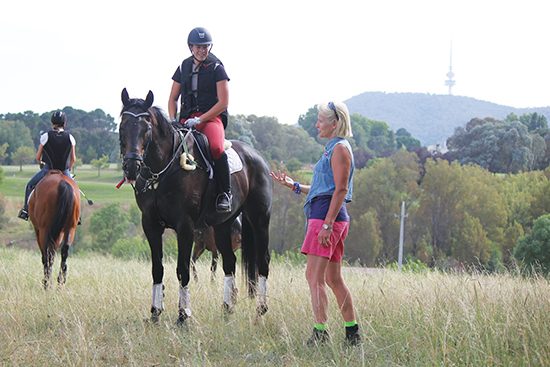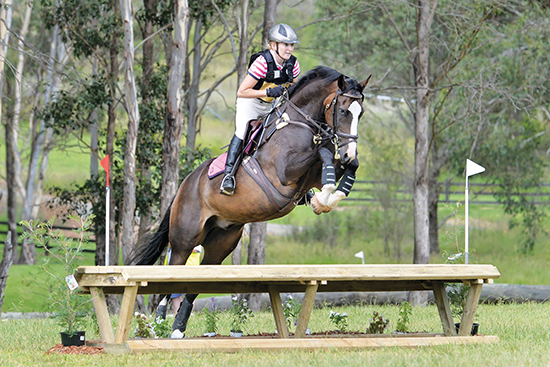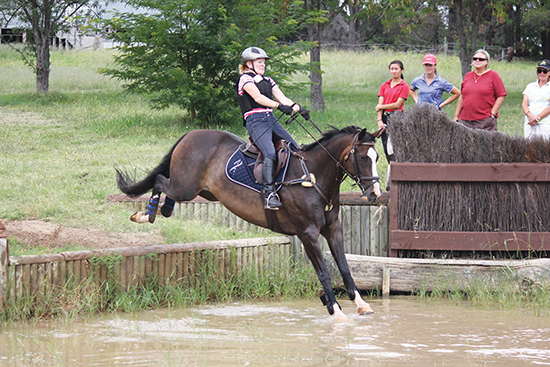 Words by Alice Dawkins & Photo by Karen Yanik
Words by Alice Dawkins & Photo by Karen Yanik
The Canberra leg of Lucinda Green’s international coaching tour couldn’t have come at a more opportune time. After taking a stack at the second-last jump in the Young Rider 1* at the Lakes and Craters CCI last December, I was quite enthused about learning how to finish the cross-country phase by passing through the finish flags – and not through my horse’s ears.
All participants in Lucinda’s clinic, hailing from as far north as Newcastle and as far south as Shepparton, were equally keen to improve their cross-country technique for the upcoming season. With many combinations returning into full work after taking the summer off, there was no shortage of cobwebs to dust off, as became evident in the 1* class, where most of us failed on the first attempt at Lucinda’s notoriously testing angled lines and combinations. With a lively appeal for all of us to get our collective acts together, following the end of the first day Lucinda concluded that she was glad to see – eventually – that we could ride a bit.
Her cross-country methodology is well-known and has been discussed in detail in this publication before. The refreshing thing about attending any Lucinda clinic is that her training scheme is never stagnant, rather, dynamic and constantly adapting to different combinations and different countries’ equestrian cultural contexts. Far from a technique-heavy laying down of rules, Lucinda’s classes appealed to something more visceral in the riders.
The two days were an education not just in the physicality of maneuvering a horse through obstacles and staying on for the ride, but an education in heightening horse and rider sensitivities, sharpening the communication line between the two to be laser-precise, and building a trust not only from the horse to the rider, but most importantly, from the rider to themselves. The pictures of harmony that ensued were testament to the fact that skillful event riding is just as much art as it is sport.
In the aftermath of the WEG, and the inevitable introspection in Australia that abounds from fifteen years since the run of three Olympic gold eventing team medals, the quest to re-think our approach to eventing as a nation is in full flight. Lucinda’s comments were particularly timely. Prefaced by the reminder that no eventing team stays at the top forever, and that peaks and troughs are inevitable, Lucinda is quick to comment on the importance of an equilibrium both in the small picture, and a larger, meta-picture.
The big picture equilibrium is the need for Australian eventers to re-channel horsemanship skills learnt from the generations where equestrian sport was practiced in far-flung pony clubs, in agricultural shows, and in sprawling paddocks. Indeed, there’s been a fair amount lost in translation as we have attempted to master those elusive Western European training systems. In our pursuit for excellence – whether at the elite level, or in Newcomers, the vast open spaces where horses learn to watch their feet and riders learn to respond to instantaneous changes in terrain have been eschewed for the ménage. It’s a trend that most of the world seems to find incredulous, considering our uniquely good natural terrain and weather.
In re-adjusting the imbalance in the meta-picture back to a state of equilibrium, Lucinda’s advice begins with the individual training regime. The desired outcome is the cultivation of a natural instinct between the horse and rider to respond to the obstacles presented in front of them, whether the visible, tangible jumps on a cross-country course, or the movements required in a dressage test. The attainment of this is a creative approach to training. Michael Jung, Lucinda’s favourite example of the exemplary event rider of today, incorporates cross-country schooling into his training on a daily basis. Anyone who watched him guide a nine-year-old mare around the WEG with that much grace can understand the benefits of working through mini cross country tests every day.
The inherent delicacy embedded into Lucinda’s teaching is often ignored or simply misunderstood, in the steady stream of reports and articles which predictably refer to an irrelevance of seeking a ‘pretty spot’ to a fence, a particularly defensive jumping seat, and the liberty given to the riders to use their physicality in whichever way works to get the job done. Perhaps some of these points are true for the most novice of riders, but the reality of Lucinda’s style is one of high class nuance. Watch any video of Lucinda’s own riding at one of her many victorious events and the truth becomes evident. It is a style where the natural abilities of horse and rider fuse to produce a type of riding which just happens. It is neither the brazen use of tough aids, nor indiscriminate grittiness. Lucinda’s tutelage at its very best produces that quality all riders strive for but few master – feel.
By the end of the two days, we had been equipped with a host of techniques for our eventing training armory, all of which combined to train us to ride with versatility and sensitivity. The takeaway point for me, beyond the rudimentary grids and angle combinations, was to re-think eventing entirely. Too often, riders approach the three phases of eventing as three discrete bodies of knowledge. We school dressage in a dressage arena, showjumping in a showjumping ring, and cross-country on a competition or training course, but never think to swap the methods around to complement and better each other even more. As I navigated a set of angled uprights, I discovered a collected canter with an unprecedented lightness that I used with great success in my next dressage test. The intense workout of your upper body strength that the right-angled jumping combination produced drew straight into how I held a steady position on landing at a showjump treble.
As event riders, we too-often perceive ourselves as riders who are equal parts dressage, showjumping, and cross-country rider. This three-way split creates mediocrity and precludes us from striving to have an identity that pure dressage and pure showjumping riders cannot – a dynamic, adaptable, and highly versatile rider with a mastery of elegance one second and raw athleticism the next.
Leah in the Preliminary at Sydney / Photo: Peter Orr
LEAH BROWN FINDS INSPIRATION
The winner of our Facebook competition was Leah Brown and she was delighted with the experience:
“What an amazing four hours I had with Lucinda at Equestrian Park in Canberra! Along with five others we were guided through a set of exercises using show jumps, followed by a somewhat gruelling session over water, skinnies and ditches, where we were shown the fundamentals of cross country safety and success. By achieving a secure seat, having 3/4 of the horse in front of you and knowing what to do when things go wrong, I feel completely prepared to take the step from Introductory to Preliminary, which is quite a jump for this Mummy-of-three wannabe eventer!”
“The main thing for me was definitely the safety seat that she promotes. Sitting back – she used the analogy, like a power point plugging into the three points. Sitting back so that if your horse does stop, you don’t go flying over the front. Being an amateur rider with three kids, I don’t want to have any accidents, and I do find that if I get nervous, my instinct is to grip and lean forward a bit. Lucinda was constantly correcting us, and once you get used to the sitting back feeling, it is definitely a safer feeling.”
Participating in Lucinda’s clinic
The horse?
“Jayem Bliquo, he’s an eight year old Warmblood / Stock Horse cross. I’ve had him since he was five – he was bred by a friend of mine in Central Queensland. We’ve been doing dressage up to Elementary, and up until last week, eventing up to Intro. We’ve won a few Intros, and had a few seconds and thirds, it was time to move up, so we did a Prelim at Sydney last week.”
“We didn’t place, but we were clear cross country, one rail down in the showjumping which was my fault. The dressage, we were very tired from the Lucinda Clinic, and then a dressage competition a few days after that, the test was a bit lack lustre, we were half way down the leader board after the dressage – which is not like us, but I can live with that. I was really happy to get round the cross country course with no jumping penalties, just some time penalties.”
You were sitting in Lucinda’s approved manner?
“Absolutely. There were definitely some questions for us on our Prelim course, I was quite conscious of needing to sit back and really ride him into the jumps, and to be prepared for a stop. There were no stops, but he did come close at a big Trakehner, and I really did feel that the seat I had, helped drive him over it.”
“I am now completely inspired to get my horse showing ‘rampant desire’ to the fences and continue on my adrenaline filled journey that is moving through the grades of eventing!”
This article originally appeared in the April 2015 edition of The Horse Magazine.




